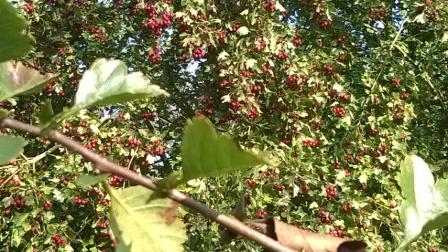Edible trees
The inner bark of (young) aspen (Populus) is (especially in spring) as quit edible. That of spruce (Picea) you harvest close to the roots, it contains a lot of vitamin C. Also birch, alder, yellow maple, pine, larch, poplar, sugar maple and willow are suitable. You can cook strips like spaghetti or grind it into flour. The very young needles of pine (Pinus) tastes good (also for tea), and sap of maple (Acer), linden, sycamore and birch can be reduce to syrup.
See also <Lemonade> for manna.)
Wood chips from linden (Tilia) were due to the high starch content fed to the cattle.
 Edible hedge
Edible hedge
With blackthorn, hawthorn and hazel this is an 'edible hedge'. Other prickly fruit carriers that may appear between are rose hips and blackberries. (The latter is to keep within bounds because it expands harder.)
Is wood edible?
Licorice which we sometimes nibble is not wood, but the sweetener containing root of Glycyrrhiza glabra shrub.
We are no woodworm, beaver or fungus. We not digest cellulose, but the structure and composition is very similar to starch. Both are glucose molecules with a slightly different bond. For years, scientists try to find a way to change the (non - digestible) beta - glycosidic bond of cellulose into the alpha - glycosidic bond of starch. Using an enzyme cocktail and genetically engineered bacteria team (Mr. Zhang) of the Virginia Tech University found a working method in 2013.
During the war was already sawdust mixed into Erzats bread.
For this addition, there is still no prohibition or regulation. Cellulose would work and taste like fat. By adding products can be made with good taste, high in fiber, very inexpensive and with few calories. According to some sources, this would already take place in a surprisingly large scale.
In the event of famine, crushed tree bark and sawdust have also been mixed with the grain of grains, and in Norway and Sweden one still bakes a kind of bread. Bread from fine sawdust is less objectionable than it seems, since the cellulose is convert...by treatment with acid in sugar (but only for) a small proportion so that it has virtually no nutrient power.
Edible tree leaves
Besides nuts (beechnuts, hazelnuts, walnuts, chestnuts) berries (mountain ash) and other fruits , there are seven edible leaves.
Young pine needles (the light green buds for tea) and young leaves of linden (nutritious), silver birch (slightly bitter), hawthorn (UK: bread and cheese tree, because once it was daily food) and beech can be used as vegetable in salad (and for tea).
Of grapevine you pick the large leaves when young and tender. Blanch them briefly in salted water, and fill them with vegetarian or meat filling. The leaves can also be pickled in salt water.
Maple leaves are fried in batter in Japan. In Minoh (North Osaka) the leaves are pre-stored in salt barrels for a year. Elsewhere they don’t. Dip one side of a (Japanese) maple leaf in batter. Bake brown in hot vegetable oil and let it drip. Possibly sweeten it with maple syrup.
Of both finely-leaved (Tilia cordata) and large-leaved lime (Tilia platyphyllos) can be used the linden leaf as well as sap and linden blossom. You can drink the juice or reduce it to syrup.
Of the Chinese maggi tree (Toona sinensis or (French) Onion Soup Tree), young shoots and (green and red) leaves are harvested as much eaten vegetables (Xiang Chun Ya: fruit tree). The taste is spicy as Maggi and aromatic onions. You can eat this seasoning raw or steamed or stir-fry. The tree is hardy in our climate. In the garden they are conveniently truncated at 50 cm above the ground. Leaves are useful for a type of pesto and for medicinal tea. Twigs and wood are also burned as incense. Flowering time: June-July.
You can sprinkle elm seeds over the salad.
Tempura batter
Beat 1 egg in a bowl, add 1 cup cold water and 1 cup sifted flour and mix lightly.
